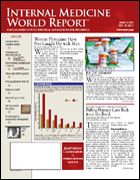Publication
Article
Women Less Likely to Have Typical Warning Signs of Stroke
Author(s):
Surprising Gender Differences Common in In-Hospital Treatment
San Francisco—Classic stroke symptoms are often absent in women. Whether or not gender-related symptom differences explain the treatment delays in women with stroke, however, remains to be determined, investigators reported at the American Stroke Association (ASA) annual meeting.
Women are also less likely than men to receive tissue plasminogen activator (t-PA) as a treatment for stroke. For instance, in a Michigan stroke registry, about half as many women received t-PA compared with men, noted Julia Warner Gargano, MS, a PhD candidate in the department of epidemiology at Michigan State University in East Lansing.
In addition, women with stroke arrive later at the emergency department, wait longer to see an emergency department physician, and wait longer after arriving at the emergency department before seeing a neurologist.
The chief complaints consistent with the ASA’s warning signs for stroke are:
• Numbness/weakness
• Confusion/trouble speaking
• Difficulty seeing
• Problems with walking and/or dizziness
• Headache.
For this retrospective study, chief complaints were analyzed from 1724 emergency department patients who were ultimately confirmed to have a stroke. “The big difference is that 10% of males and 15% of females had none of the 5 warning signs, at least as they described in their chief complaint,” said Ms Gargano.
After adjusting for other factors, women in this study were:
• 40% less likely to report difficulty with walking/balance or coordination/dizziness
• 20% less likely to report trouble seeing
• 33% less likely to report any of the 5 warning signs listed above.
The most common complaints among patients without any of the typical warning signs were:
• Loss of consciousness or syncope
• Respiratory problems
• Falls or accidents
• Pain
• Seizure.
Each of these complaints was more common in women than in men. For example, of those with pain as their chief compliant, 70% were women, and of those with falls or accidents as the chief complaint, 63% were women.
“Our research group is currently ­trying to understand the role of the presenting symptoms on delays in evaluation observed in our Michigan stroke registry data,” she said. These data show that 59% of men, but only 44% of women, ultimately confirmed to have a stroke (but who arrive <2 hours after symptom onset) receive brain imaging within 60 minutes of emergency department arrival.
“This was present in every age-group that we considered, so it’s not simply explained by women being older,” she added.
The retrospective nature of this study is its major limitation, said Devin Brown, MD, assistant professor of neurology at the University of Michigan in Ann Arbor. “It’s unclear whether the differences are what is actually being experienced, what is being evoked by the physician or interviewer, or what is being volunteered by the patient,” she said.
Studies have shown that, in women, diagnostic evaluation for stroke is inferior to that in men in certain re­gions, antiplatelet agents are less frequently used, and anticoagulation is less common, said Dr Brown.






